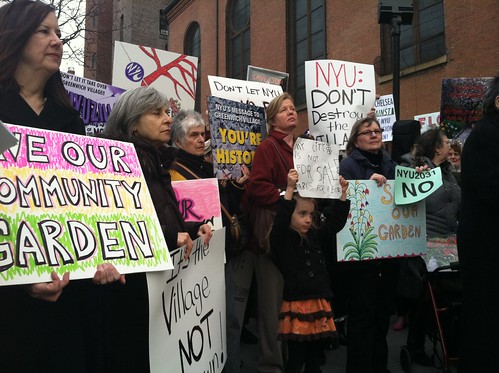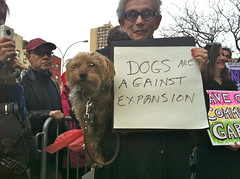The ambitious expansion of New York University faced its first formal rejection last night, as Community Board 2 voted unanimously against the plan, saying it would turn Greenwich Village into a construction site for at least 19 years and fundamentally change the neighborhood for the worse.
Not a single person spoke in favor of the plan during over two hours of testimony in the packed basement of St. Anthony of Padua Church on 154 Sullivan Street. After 115 locals, academics and students skewered the plan that would add four new university buildings and 2.5 million square feet of space just south of Washington Square Park, the board cast its vote in opposition to the expansion dubbed “N.Y.U. 2031.”
“We’re here tonight to firmly reject this plan,” said board chair Brad Hoylman. “It’s clear that there is no support for this insidious plan that would destroy the culture of Greenwich Village.”
Cheers went up from the standing-room only audience after the vote, though its impact is limited, given that it is only an advisory opinion. The project will next be considered by Manhattan Borough President Scott Stringer, the City Planning Commission and the City Council, which will ultimately determine the project’s fate.
N.Y.U. Vice President Alicia Hurley made it clear yesterday’s vote was only one step in a long process.
“The University will review the resolution that Community Board 2 has put forth, but looking beyond tonight’s vote, we look forward to continuing the discussion with the broader community and the City about our academic needs,” Ms. Hurley said in a statement. “N.Y.U. appreciates the community’s feedback to date and believes that our five-year dialogue with our neighbors has already yielded tremendous results.”
She later added that the proposal “avoids eminent domain and residential tenant displacement, all while allowing N.Y.U. to sustain its academic momentum and create thousands of new jobs.”
But any benefits of the expansion plan were not on the minds of the speakers last night.
Prior to the meeting, dozens of protestors — and even a few dogs — joined the executive director of the Greenwich Village Society For Historic Preservation, Andrew Berman at the corner of Houston and Sullivan Streets.
“New York University is asking the city to give them special permission to overturn longstanding neighborhood zoning protections, to take over public land used as parks, to get rid of urban renewal deed restrictions so that they can shoehorn 2.5 million square feet of space into the blocks south of Washington Square Park,” said Mr. Berman. “That is the equivalent of the Empire State Building in the middle of Greenwich Village, and we say no!”
The project would require the demolition of three buildings owned by N.Y.U., including the Morton-Williams supermarket building and the Coles Sports and Recreation Center, which would both be replaced. The project footprint is bound by LaGuardia Place and Mercer Street and West Third and Houston Streets.
Howard Negrin, the president of the Washington Place Block Association, was skeptical of the additional retail space that would be built east of Washington Square Park. “It is clear that N.Y.U.’s specious argument is nothing more than to realize additional revenue without any thought of impact of commercialization or economic well-being of surrounding areas,” he said.
While the university has not released an official price tag for the work, external estimates place the would-be construction tab at $6 billion dollars, according to Mark Crispin Miller, professor of media culture and communication at N.Y.U. and representative of a faculty group against the expansion.
“There are actually no good reasons for it,” said Mr. Miller. “The only thing [the university says] is that it would make N.Y.U. a stronger institution academically, and that is actually the opposite of the case.”
He added that the rumored price tag of the project jeopardized the university. “Clearly, they will have to either jack up the tuition, or let in thousands more students, or both. If they’re going to let in thousands of additional students, they’re going to have to lower their admission standards. N.Y.U. has spent years trying to improve its academic standing. How will that continue?”
Debashree Mukherjee, a graduate student in cinema studies, shared Mr. Miller’s skepticism. “[N.Y.U.] wants us to trust that education is their main interest, even as their exorbitantly priced education excludes more students than it empowers,” she said.
While the university has not proposed an alternate plan or location for additional space, community members were happy to suggest one: the financial district and the unfinished 3 World Trade Center.
Jean Grillo, a member of Community Board 1, trumpeted the idea at the pre-meeting protest and during the hearing. “I say bring N.Y.U. downtown.” said Ms. Grillo. “New York City is having trouble filling Tower 3, and we’re saying, ‘Come on down, we have the welcome mat out. We want you!’”






